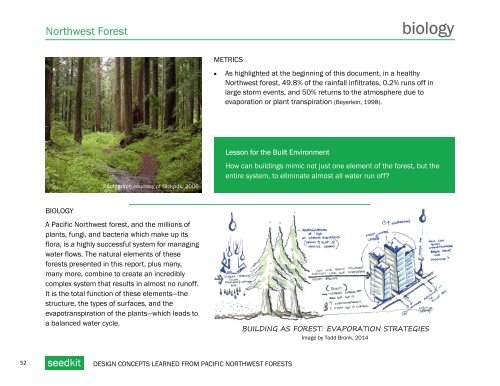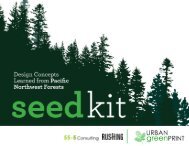You also want an ePaper? Increase the reach of your titles
YUMPU automatically turns print PDFs into web optimized ePapers that Google loves.
Northwest Forest<br />
biology<br />
METRICS<br />
· As highlighted at the beginning of this document, in a healthy<br />
Northwest forest, 49.8% of the rainfall infiltrates, 0.2% runs off in<br />
large storm events, and 50% returns to the atmosphere due to<br />
evaporation or plant transpiration (Beyerlein, 1998).<br />
Photograph courtesy of Nickpdx, 2006<br />
Lesson for the Built Environment<br />
How can buildings mimic not just one element of the forest, but the<br />
entire system, to eliminate almost all water run off?<br />
BIOLOGY<br />
A Pacific Northwest forest, and the millions of<br />
plants, fungi, and bacteria which make up its<br />
flora, is a highly successful system for managing<br />
water flows. The natural elements of these<br />
forests presented in this report, plus many,<br />
many more, combine to create an incredibly<br />
complex system that results in almost no runoff.<br />
It is the total function of these elements—the<br />
structure, the types of surfaces, and the<br />
evapotranspiration of the plants—which leads to<br />
a balanced water cycle.<br />
BUILDING AS FOREST: EVAPORATION STRATEGIES<br />
Image by Todd Bronk, 2014<br />
52 seedkit DESIGN CONCEPTS LEARNED FROM PACIFIC NORTHWEST FORESTS



